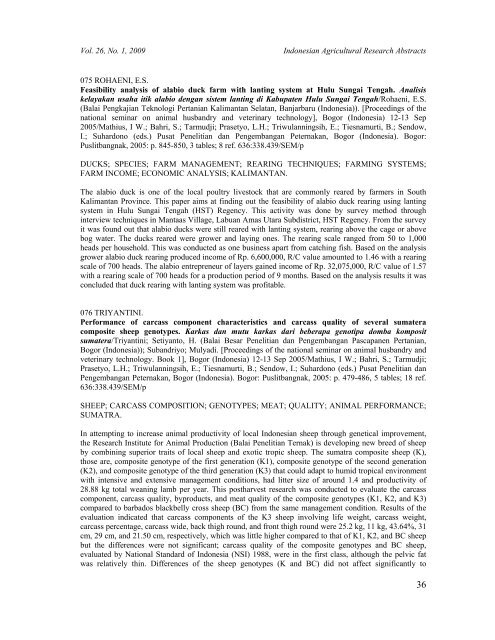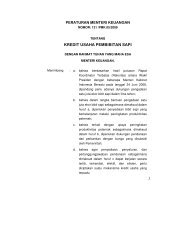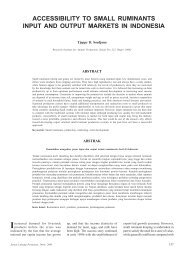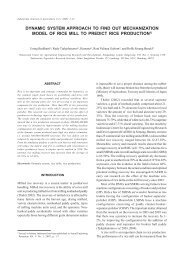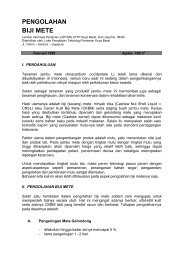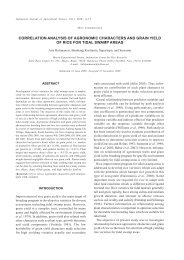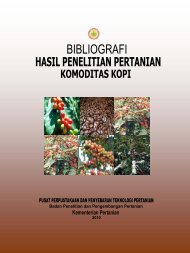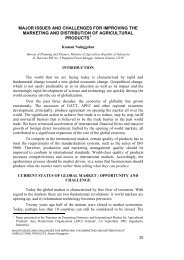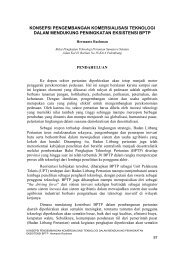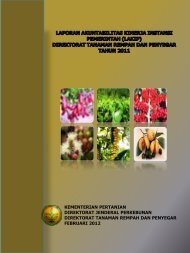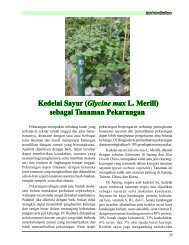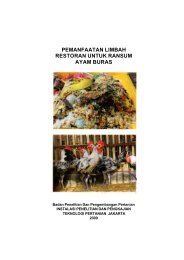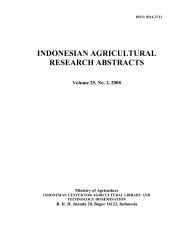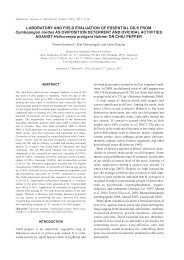Indonesian Agricultural Research Abstracts <strong>Vol</strong>. 26, <strong>No</strong>. 1, <strong>2009</strong>A study on the improvement of slaughtering management of local beef has been conducted throughselecting slaughter beef, improving ante mortem management, slaughtering and post mortem handling. Asmany as 4 male ongole grade cattle, 270-370 kg slaughters weight, body score conditions (BSC) of 7 wereslaughtered at a standard manner with a minimum stress. After carcass aging period of 12 hours at roomtemperature of 15-16°C, top side meat sample was taken as many as 6 kg. As a comparison, 6 kg oftopside cuts was taken from different batchs of imported beef. Both beef samples were objectivelyanalyzed to measure their cooking loss values, while hedonic analysis was conducted through pan-broilingsteak method, and assigning panel study involving 30 guests of Patra Convention Center Hotel atSemarang to measure firmness and taste traits. Based on t-student test, it could be concluded that selectingslaughter local beef at BCS=7 and standard slaughtering management was significantly (P>0.05) able toimprove local beef meat quality as good as imported one. The average value of cooking loss, firmness, andtaste were 21.63%, 2.54, and 2.98, respectively. Based on the results, it can be concluded that if theslaughtering procedures and management were conducted in a standard manner, the quality of local beefmeat could be improved as good as the imported one.L01 ANIMAL HUSBANDRY074 GINTING, S.P.Development of goat-palm oil integrated production system: an assessment based on feedavailability and nutrient requirements. Pengembangan sistem integrasi usaha ternak kambingdengan perkebunan kelapa sawit: kajian berdasarkan ketersediaan pakan dan kebutuhannutrisi/Ginting, S.P. (Loka Penelitian Kambing Potong, Galang, Sumatera Utara (Indonesia)). WartazoaISSN 0216-6461 (2006) v. 16(2) p. 53-64, 2 ill., 7 tables; 29 ref.GOATS; ELAEIS GUINEENSIS; INTEGRATION; CARRYING CAPACITY; FEEDS; STOCKINGDENSITY; ANIMAL POPULATION.The integration of goats and palm oil plantation is prospective agricultural production systems that exploitthe complementary relationship among various components in the system. The main components are theoil palm trees, vegetation underneath the trees, processing plant of palm oil bunch, and the goat. Theestimation of carrying capacity of the plantation system is based on the quantitative analysis on nutrientsupply from various feed resources in the plantation system and nutrient requirements for goat production.The goat demographic parameters, such as prolificacy, fertility and fecundity are used to estimate goatpopulation size, dynamics and structures. The development of production model could be based on acertain production target, such as the number of animals sold or the amount of income (demand drivenapproach), or based on the availability of certain resources such as feed supply (supply driven approach).Using the demand driven approach, and considering 6000 heads of one-year old goats to fill the Malaysianmarket as the production target, it is calculated that a population size of 3,636 does and 810 ha of palm oilplantation are required to meet this production target. In a typically medium-size oil palm plantationsystem (500 ha of oil palm plantation) with one unit of small scale palm oil bunch processing plant (1ton/hour), the potency to supply metabolisable energy from various feed resources in the system is2,778,800 Mcal/year, equivalent to a carrying capacity of 5,155 Goat Units/year. This system could carry2,951 does and 295 bucks to produce 1,116 heads of one-year old goats annually. A medium-size oil palmplantation without processing plant unit is potential in supplying metabolisable energy of 1,983,300Mcal/year, equivalent to a carrying capacity of 3,680 Goat Units/year. In order to fill the export market toMalaysia, a number of 10 units of medium sized plantation with small scale plant processing or a numberof 17 units medium scale plantation without processing unit are required. Using similar approach, thepotential of either large-scale or small scale plantation system to produce goat in an integrated productionsystem could be estimated.35
<strong>Vol</strong>. 26, <strong>No</strong>. 1, <strong>2009</strong>Indonesian Agricultural Research Abstracts075 ROHAENI, E.S.Feasibility analysis of alabio duck farm with lanting system at Hulu Sungai Tengah. Analisiskelayakan usaha itik alabio dengan sistem lanting di Kabupaten Hulu Sungai Tengah/Rohaeni, E.S.(Balai Pengkajian Teknologi Pertanian Kalimantan Selatan, Banjarbaru (Indonesia)). [Proceedings of thenational seminar on animal husbandry and veterinary technology], Bogor (Indonesia) 12-13 Sep2005/Mathius, I W.; Bahri, S.; Tarmudji; Prasetyo, L.H.; Triwulanningsih, E.; Tiesnamurti, B.; Sendow,I.; Suhardono (eds.) Pusat Penelitian dan Pengembangan Peternakan, Bogor (Indonesia). Bogor:Puslitbangnak, 2005: p. 845-850, 3 tables; 8 ref. 636:338.439/SEM/pDUCKS; SPECIES; FARM MANAGEMENT; REARING TECHNIQUES; FARMING SYSTEMS;FARM INCOME; ECONOMIC ANALYSIS; KALIMANTAN.The alabio duck is one of the local poultry livestock that are commonly reared by farmers in SouthKalimantan Province. This paper aims at finding out the feasibility of alabio duck rearing using lantingsystem in Hulu Sungai Tengah (HST) Regency. This activity was done by survey method throughinterview techniques in Mantaas Village, Labuan Amas Utara Subdistrict, HST Regency. From the surveyit was found out that alabio ducks were still reared with lanting system, rearing above the cage or abovebog water. The ducks reared were grower and laying ones. The rearing scale ranged from 50 to 1,000heads per household. This was conducted as one business apart from catching fish. Based on the analysisgrower alabio duck rearing produced income of Rp. 6,600,000, R/C value amounted to 1.46 with a rearingscale of 700 heads. The alabio entrepreneur of layers gained income of Rp. 32,075,000, R/C value of 1.57with a rearing scale of 700 heads for a production period of 9 months. Based on the analysis results it wasconcluded that duck rearing with lanting system was profitable.076 TRIYANTINI.Performance of carcass component characteristics and carcass quality of several sumateracomposite sheep genotypes. Karkas dan mutu karkas dari beberapa genotipa domba kompositsumatera/Triyantini; Setiyanto, H. (Balai Besar Penelitian dan Pengembangan Pascapanen Pertanian,Bogor (Indonesia)); Subandriyo; Mulyadi. [Proceedings of the national seminar on animal husbandry andveterinary technology. Book 1], Bogor (Indonesia) 12-13 Sep 2005/Mathius, I W.; Bahri, S.; Tarmudji;Prasetyo, L.H.; Triwulanningsih, E.; Tiesnamurti, B.; Sendow, I.; Suhardono (eds.) Pusat Penelitian danPengembangan Peternakan, Bogor (Indonesia). Bogor: Puslitbangnak, 2005: p. 479-486, 5 tables; 18 ref.636:338.439/SEM/pSHEEP; CARCASS COMPOSITION; GENOTYPES; MEAT; QUALITY; ANIMAL PERFORMANCE;SUMATRA.In attempting to increase animal productivity of local Indonesian sheep through genetical improvement,the Research Institute for Animal Production (Balai Penelitian Ternak) is developing new breed of sheepby combining superior traits of local sheep and exotic tropic sheep. The sumatra composite sheep (K),those are, composite genotype of the first generation (K1), composite genotype of the second generation(K2), and composite genotype of the third generation (K3) that could adapt to humid tropical environmentwith intensive and extensive management conditions, had litter size of around 1.4 and productivity of28.88 kg total weaning lamb per year. This postharvest research was conducted to evaluate the carcasscomponent, carcass quality, byproducts, and meat quality of the composite genotypes (K1, K2, and K3)compared to barbados blac<strong>kb</strong>elly cross sheep (BC) from the same management condition. Results of theevaluation indicated that carcass components of the K3 sheep involving life weight, carcass weight,carcass percentage, carcass wide, back thigh round, and front thigh round were 25.2 kg, 11 kg, 43.64%, 31cm, 29 cm, and 21.50 cm, respectively, which was little higher compared to that of K1, K2, and BC sheepbut the differences were not significant; carcass quality of the composite genotypes and BC sheep,evaluated by National Standard of Indonesia (NSI) 1988, were in the first class, although the pelvic fatwas relatively thin. Differences of the sheep genotypes (K and BC) did not affect significantly to36
- Page 5: Vol. 26, No. 1, 2009Indonesian Agri
- Page 8 and 9: Indonesian Agricultural Research Ab
- Page 10 and 11: Indonesian Agricultural Research Ab
- Page 13 and 14: Vol. 26, No. 1, 2009Indonesian Agri
- Page 15 and 16: Vol. 26, No. 1, 2009Indonesian Agri
- Page 17 and 18: Vol. 26, No. 1, 2009Indonesian Agri
- Page 19 and 20: Vol. 26, No. 1, 2009Indonesian Agri
- Page 21 and 22: Vol. 26, No. 1, 2009Indonesian Agri
- Page 23 and 24: Vol. 26, No. 1, 2009Indonesian Agri
- Page 25 and 26: Vol. 26, No. 1, 2009Indonesian Agri
- Page 27 and 28: Vol. 26, No. 1, 2009Indonesian Agri
- Page 29 and 30: Vol. 26, No. 1, 2009Indonesian Agri
- Page 31 and 32: Vol. 26, No. 1, 2009Indonesian Agri
- Page 33 and 34: Vol. 26, No. 1, 2009Indonesian Agri
- Page 35 and 36: Vol. 26, No. 1, 2009Indonesian Agri
- Page 37 and 38: Vol. 26, No. 1, 2009Indonesian Agri
- Page 39: Vol. 26, No. 1, 2009Indonesian Agri
- Page 43 and 44: Vol. 26, No. 1, 2009Indonesian Agri
- Page 45 and 46: Vol. 26, No. 1, 2009Indonesian Agri
- Page 47 and 48: Vol. 26, No. 1, 2009Indonesian Agri
- Page 49 and 50: Vol. 26, No. 1, 2009Indonesian Agri
- Page 51 and 52: Vol. 26, No. 1, 2009Indonesian Agri
- Page 53 and 54: Vol. 26, No. 1, 2009Indonesian Agri
- Page 55 and 56: Vol. 26, No. 1, 2009Indonesian Agri
- Page 57 and 58: Vol. 26, No. 1, 2009Indonesian Agri
- Page 59 and 60: Vol. 26, No. 1, 2009Indonesian Agri
- Page 61 and 62: Vol. 26, No. 1, 2009Indonesian Agri
- Page 63 and 64: Vol. 26, No. 1, 2009Indonesian Agri
- Page 65 and 66: Vol. 26, No. 1, 2009Indonesian Agri
- Page 67 and 68: Vol. 26, No. 1, 2009Indonesian Agri
- Page 69 and 70: Vol. 26, No. 1, 2009Indonesian Agri
- Page 71 and 72: Vol. 26, No. 1, 2009Indonesian Agri
- Page 73 and 74: Vol. 26, No. 1, 2009Indonesian Agri
- Page 75 and 76: Vol. 26, No. 1, 2009Indonesian Agri
- Page 77 and 78: Vol. 26, No. 1, 2009Indonesian Agri
- Page 79 and 80: Vol. 26, No. 1, 2009Indonesian Agri
- Page 81 and 82: Vol. 26, No. 1, 2009Dickinson, M.J.
- Page 83 and 84: Vol. 26, No. 1, 2009Indonesian Agri
- Page 85 and 86: Vol. 26, No. 1, 2009Indonesian Agri
- Page 87 and 88: Indonesian Agricultural Research Ab
- Page 89 and 90: Indonesian Agricultural Research Ab
- Page 91 and 92:
Indonesian Agricultural Research Ab
- Page 93 and 94:
Indonesian Agricultural Research Ab
- Page 95 and 96:
Indonesian Agricultural Research Ab
- Page 97 and 98:
Indonesian Agricultural Research Ab
- Page 99:
Indonesian Agricultural Research Ab


